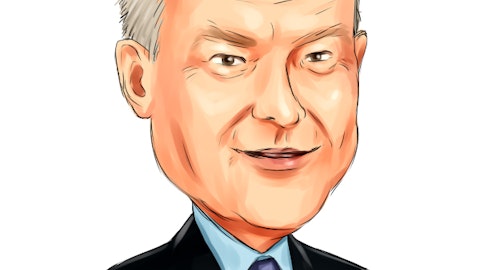Rogers Corporation (NYSE:ROG) Q3 2023 Earnings Call Transcript October 26, 2023
Rogers Corporation beats earnings expectations. Reported EPS is $1.24, expectations were $1.15.
Operator: Good afternoon. My name is Shamali and I will be your conference operator today. At this time, I would like to welcome everyone to the Rogers Corporation Q3 2023 Earnings Conference Call. I will now turn the call over to your host, Mr. Steve Haymore, Director of Investor Relations. Mr. Haymore, you may begin.
Steve Haymore: Good afternoon, everyone, and welcome to the Rogers Corporation third quarter 2023 earnings conference call. The slides for today’s call can be found on the Investors section of our website, along with the news release that was issued earlier today. Please turn to Slide 2. Before we begin, I’d like to note that statements in this conference call that are not strictly historical are forward-looking statements within the meaning of the Private Securities Litigation Reform Act of 1995 and should be considered as subject to the many uncertainties that exist in Rogers’ operations and environment. These uncertainties include economic conditions, market demand, and competitive factors. Such factors could cause actual results to differ materially from those in any forward-looking statements made today.
Please turn to Slide 3. The discussions during this conference call will also reference certain financial measures that were not prepared in accordance with generally accepted accounting principles. Reconciliations of those non-GAAP financial measures, the most directly comparable GAAP financial measures can be found in the slide deck for today’s call. Turning to Slide 4. With me today is Colin Gouveia, President and CEO; and Ram Mayampurath, Senior Vice President and CFO. I will now turn the call over to Colin.
Colin Gouveia: Thanks, Steve. Good afternoon to everyone, and thank you for joining us today. Before we turn to the next slide, I’ll give a quick summary of our performance during the quarter. In Q3, we again made good progress towards the cost improvement targets we set for this year. Gross margin was 35.1%, which was above the high end of our guidance range and exceeded the target we set in Q1. This margin expansion and lower adjusted operating expenses drove adjusted EPS to the high end of our guidance range and contributed to the stronger cash flow generated in the quarter. We achieved these margin improvements despite continued global economic headwinds impacting market demand. Later in the presentation, I will elaborate more on these market headwinds and our Q3 results.
But first, I want to highlight the progress we are making to strengthen the company as we execute on our restore initiatives introduced during our Q1 Investor Day. Please turn to slide 5. Rogers has a history of capitalizing on secular trends in fast growing markets. We do this by leveraging our core technology and product strength in existing markets and applying it to new growth areas. One example of this is the EV market. where our sales have increased rapidly over the past several years. With significant growth ahead, we are adding new capacity in our curamik power substrate business to support our customers. We have secured many design in wins for curamik this year, and our momentum in this space continues. For example, last quarter, a major power module supplier designed in our advanced substrate technology in their high performance silicon carbide power modules.
This technology will be used in the main inverter of a major European automotive OEM. This win is one of the largest in our history and reflects the tremendous growth in silicon carbide solutions for EVs and the need for our substrate technology. We also have had good success in the EV battery market. Recently, we secured two design wins with a leading Asian and North American OEM respectively. These strategic customers will utilize our compression pad solutions in the battery modules for some of their leading platforms. Our technology was selected for its proven performance, consistency, and reliability. Both design wins are projected to extend over multiple years. Second, products and process innovation leadership are critical to our success and growth potential.
We highlighted several examples of product innovation at our Investor Day in March, including the latest RF materials that enable antenna miniaturization for defense applications, advanced polyurethane materials that improve EV battery performance, and our power substrates, which deliver integrated cooling solutions. In the area of process innovation, we have a significant body of work underway in both AES and EMS to improve manufacturing performance, reliability, and operational efficiencies. Improving operational effectiveness remains a key component to our long-term strategy. Throughout this year, focusing on key leadership hires has been a priority. The senior leadership team is now complete, with Griffin Gappert joining Rogers as Chief Technology Officer.
Griffin comes to us from Henkel, where he was the Global Head of Innovation for Henkel’s Adhesives Automotive OEM business. Griffin has extensive R&D leadership experience at large multinational companies driving next generation technology. His deep expertise in advanced electronic and elastomeric materials makes him a natural fit for this role. Third, we continue to focus on operational excellence to drive profitability improvements. As I touched on earlier, we have made substantial progress here. We have improved gross margins in three consecutive quarters and are not letting up on our efforts. With strengthened operations and supply chain leadership, we are focused on driving procurement savings, yield and scrap improvements, and other initiatives in the ops and supply chain space.
Lastly, I’ll touch on synergistic M&A, where we are focusing on companies with differentiated technologies that complement our existing product portfolio. Over the past nine months, we have bolstered our business development organization and have reinvigorated our pipeline of potential acquisitions. The timing of future acquisitions will be subject to many factors, but it remains an important component of our growth plans. 10 months into my tenure as CEO, we have made great progress in the restore phase that we described in our March Investor Day. We have added impressive talent to the organization, achieved significant improvement in our margins, and secured many new design wins. There were still much work ahead to accelerate the growth of the business, but we remain confident in our strategy and our ability to position Rogers for success.
Next, on Slide 6, I’ll provide an overview of our third quarter results. Q3 sales of $229 million were basically flat to the prior quarter and slightly below our guidance forecast due to the challenging macro environment. Our gross margin improved to 35.1%, and this result along with controlling operating expenses drove adjusted earnings per share to the top end of our guidance range. Turning to our market results, I’ll begin with industrial sales, the largest component of our core markets. Q3 industrial sales declined versus the prior quarter and reflected the ongoing challenges faced by global manufacturers. Economic activity in the manufacturing sector has now contracted 11 consecutive months in the U.S. and 15 consecutive months in the EU.
China factory activity recently saw its first expansion in six months, but the overall demand environment remains weak, and it is uncertain when we might see meaningful improvement. In our high growth markets, portable electronics increased sharply in Q3 versus the prior quarter due to strong demand for new smartphone introductions and typical seasonal order patterns. We continue to have leading technology in high end phones that provide robust protection to improve device reliability and performance. Renewable energy sales declined slightly due to customer order patterns after very strong sales in the second quarter. For the year, sales have increased more than 30%, reflecting strong demand for our power substrates for solar and wind inverters.
We expect this to continue to be a strong opportunity for growth moving forward. Rounding out our high growth markets, aerospace and defense sales were flat to the prior quarter and ADAS sales declined. Year-to-date ADAS sales have grown at a high single-digit rate and sales are typically stronger in the first half of the year. Our significant growth market tier, comprised of EV/HEV sales, declined versus Q2 primarily due to lower power substrate sales as customers managed inventory levels. We anticipate EV growth to resume in Q4. On a year-to-date basis, our power substrate sales are significantly higher versus the prior year. EMS and ROLINX EV sales were up slightly versus the prior quarter. EV sales growth for these product lines continues to be dependent on certain customers who are working through production ramp challenges or high inventory levels.

Turning to Slide 7, I’ll next highlight some of the drivers we see leading to higher sales in the coming quarters. Some of these factors can be controlled directly and others are subject to improved market conditions. First, we have seen a significant impact to 2023 sales from lower overall demand in the general industrial and portable electronics markets. These two markets represent close to 40% of Rogers’ sales. As discussed earlier, industrial sales declined significantly in Q3 and are down for the full-year. Although our portable electronics sales improved in Q3, year-to-date sales are behind prior year. This is reflective of the global smartphone market, which has at its lowest point in a decade. Worldwide sales of tablets and smart speakers are also projected to be down sharply with declines of 15% or more versus prior year.
Visibility is limited to when demand may improve, but when these markets do improve, the benefit to our P&L will be meaningful. Next, we expect increased sales in coming quarters associated with design wins in the EV space. This is particularly the case in our EMS business, where demand from certain customers is expected to grow as vehicle production rates increase. The magnitude and timing of these incremental sales will be subject to how quickly the production ramp proceeds. The remaining two items relate to production capacity for our curamik power substrate manufacturing. The process innovation efforts referenced earlier are helping curamik unlock additional output at our factory in Germany, enabling us to increase sales in 2024. This incremental capacity will support our customers until our new China facility comes online, which we expect will be in late 2024.
Of all these activities, the new curamik plant is expected to provide the most significant boost to revenue. This is not a complete list, but highlights some of the key drivers of future growth. As this relates to the 2025 targets that we outlined at our Investor Day, we’re not making any updates at this point. We continue to focus on executing on the key priorities in our restore, accelerate, and elevate phases to achieve the targets we set, including annual sales in the range of $1.2 billion to $1.3 billion. When we set this top-line target in Q1 of this year, it was based on two key assumptions. The first is the rate at which design wins would begin to ramp in 2024 and 2025. Second, it was based on a certain level of global economic recovery and growth that would return in ’24 and continue into ’25.
It’s still too early to know how these factors will evolve over the coming two years relative to our expectations. We expect to have a better view in the coming months, which will inform any potential updates to our 2025 targets. In summary, we continue to execute on our plans and proven strategy, even as market conditions remain challenging. We’re making good progress in the areas that we can control. We’re securing new design wins, improving operating costs, and managing operating expenses. We have added capacity in many different product lines to support our customers and have improved the organization with strong leadership capabilities and the tools needed to execute on our strategy. Now I’ll turn it over to Ram to discuss our Q3 financial performance and Q4 outlook.
Ram Mayampurath: Thank you, Colin, and good afternoon, everyone. Building on what Colin stated earlier, despite difficult market conditions, we have accomplished a great deal over the course of this year. We have kept our focus on improving profitability and cash flow. We’re also committed to making the investments necessary to prepare the business for long-term growth. These improvements include driving gross margins higher by 350 basis points compared to Q3 of 2022, achieving an adjusted EBITDA margins of nearly 20%, a 375 basis points improvement over the same time period. Higher cash generation that has allowed us to invest in capacity and capabilities for growth while paying down debt. Let me now review our third quarter 2023 results in detail beginning on Slide 8.
Q3 sales of $229 million declined by less than 1% versus the prior quarter and were slightly below our guidance range. Gross margin of 35.1% improved 60 basis points versus Q2 and exceeded the high end of our guidance expectation. On a GAAP basis, earnings per share was $1.02, slightly below the range, due to the timing of the expected sale of an asset held for sale. Adjusted earnings per share of $1.24 increased by 15% sequentially and was at the top end of our guidance range. We have made good progress in 2023 with our margins and adjusted EPS. We remain intently focused on driving further profitability improvements. Turning to Slide 9, I’ll discuss Q3 net sales in greater detail. The slight decline in total sales was due to lower volume of approximately $900,000 and unfavorable foreign currency fluctuations of around $700,000.
On a reportable segment basis, AES sales decreased from the prior quarter by 2.9% to $126.4 million. The less than $4 million decrease was related to lower EV/HEV, aerospace and defense, and ADAS sales. The EV/HEV sales decline was a result of short-term inventory fluctuations by some customers, and we expect to return to growth in Q4. In addition, program delays resulted in lower sales in other markets. However, we continue to see good growth opportunities in all three of these markets. EMS sales increased by 2.8% to $98 million, led by seasonally strong portable electronic sales and continued strength in our aerospace and defense. These improvements, more than offset, significantly lower industrial sales. As stated earlier, industrial sales declined more than any other market in Q3 as a result of continuing weakness in the global manufacturing sector.
Turning to Slide 10, our gross margin for the third quarter was $80.4 million or 35.1%. Despite lower volume, the improvement in gross margin versus the prior quarter was the result of direct and indirect procurement cost savings and favorable mix. In addition to manufacturing excellence, driving procurement savings continued to be a key part of our ongoing margin improvement strategy, and we are starting to see results from our efforts. Q3 adjusted net income increased to $23.2 million, an improvement of 16% versus Q2. This translates to Q3 adjusted earnings per share of $1.24, which was $0.17 better than Q2. The increase in adjusted net income resulted from improved gross margin, lower adjusted operating expenses, and higher other income.
The increase in other income was related to gain on foreign exchange transactions and lower interest expenses from debt repayments. Continuing to Slide 11, ending cash at September 30th was approximately $126 million, a decrease of $109 million from the end of 2022 and a $15 million decrease from the end of Q2 2023. We generated strong operating cash flow of $42 million in Q3, which enabled us to make a $50 million discretionary repayment of our debt on our revolving credit facility. Capital expenditures were approximately $7 million in the quarter and $35 million year-to-date. For the full-year, we now expect capital expenditures to be in the range of $55 million to $65 million. We have made good strides this year to further strengthen our balance sheet.
We have continued to invest in our long-term strategic initiatives while paying down a total of $135 million on our revolver and increasing our net cash position. Next, on Slide 12, I will discuss our guidance for the fourth quarter. First, net sales are expected to range between $215 million and $225 million. The main reason for the lower guidance related to Q3 sales that is follows. First, the fourth quarter has historically been our lowest sales point for the year as customers run with leaner inventory levels and delay some orders until the following year. For example, we are seeing this in our EMS A&D sales, which have been very strong in 2023, but are expected to decline in Q4. In addition, we anticipate the current macro challenges to amplify this typical year-end decline.
This is particularly true in industrial markets, where we expect sales to decline further in Q4. We expect EV/HEV sales to grow in Q4 relative to the third quarter, but we expect this growth will be more than offset by these other factors. We are guiding gross margin to be in the range of 34% to 35% for Q4. The 34.5% midpoint of our guidance is lower than Q3 results, reflecting the sales volume decline. Earnings per share is expected to range from $0.71 to $0.91 and adjusted EPS from $0.90 to $1.10. Our Q4 GAAP EPS range incorporates an expected gain on the sale of a small manufacturing facility. This was part of the factory footprint optimization we announced previously. We project our full-year tax rate to be around 25%. We’re focused on executing the activities that drive improved profitability and increased cash generation and remain committed to investing in the capacity and capabilities necessary to drive our future growth.
I will now turn the call back to the operator for questions.
Operator: Thank you. And at this time, we will be conducting a question-and-answer session. [Operator Instructions]. Our first question comes from the line of Daniel Moore with CJS Securities. Please proceed with your question.
See also 10 Best Rugged Smartphones in 2023 and 11 Best Stocks to Buy in Falling Markets According to Hedge Funds.
Q&A Session
Follow Rogers Corp (VTX:ROG)
Follow Rogers Corp (VTX:ROG)
Daniel Moore: Good afternoon. Thanks for taking questions. Congrats on margin progression. Maybe I’ll start with EV. There’s obviously been a lot of noise lately around EV sales slowing and you saw a little bit of slowdown in Q3, but it sounds like some winnings of very significant new orders and platforms. What are your customers and you expect to return to growth sequentially at least in Q4? So what are your customers telling you about their plans for production and expansion as they look out to ‘24 specifically and any color by geography if you could break it down kind of North America, Europe, Asia, that would be very helpful? Thanks.
Colin Gouveia: Sure, Dan. Colin here. Thanks for calling in. So you’re right, there has been a lot of information in news lately about EV from a lot of different companies weighing in. What we hear from customers in general would be there was always anticipated to be some choppiness as EV scaled up. And it comes back to the fact that some of these supply chains and getting these vehicles into the market, it just hasn’t been developed as the ICE engines have been. I mean, these the ICE materials or ICE products have been in the market for more than 100 years and the supply chain here is are still pretty nascent. So overall, even though there may be a quarter or two of an issue, most of our OEMs feel in all the regions that the growth will be there for EV, HEV.
I think there was some recent comments from Toyota around how they feel like maybe plug-in hybrids will be more effective in growing in the marketplace. But we also hear that pure battery vehicles are also going quite strong. So while there’s some bumps in the road initially, we certainly feel like long-term there’s still a good decade of growth ahead for both platforms.
Daniel Moore: Very helpful. And in general industrial, appreciate all the commentary there and obviously very consistent with what we are seeing in the macro. Maybe would you describe it as incremental slowing or just kind of continue to remain choppy overall? And one of your customers telling you about their expansion of CapEx plans beyond Q4, maybe for the next several quarters? Thanks.
Colin Gouveia: Sure, Dan. So I would describe it mostly as incremental. Within that bucket of general industrial we have a lot of different end markets, such as capital equipment, semiconductor appliances lighting. And it just feels like it’s coming to the end of the year. It’s part of the issues of the overall general economy impacting our sales into these end markets. And we’ll continue to watch it closely. Certainly high interest rates are not helping in terms of new home sales, and that would probably roll back and impact our HVAC business, which is also in the general industrial end segment. So that’s how I would look at it. Ram, I don’t know if you wanted to add anything different to that.
Ram Mayampurath: No, I agree. I think we are seeing it slower, go weaker in Q4, Dan. So it is increasingly slowing. I hope that’s the bottom of it, and we’ll start some recovery. But for now, we don’t see any recovery insight.
Daniel Moore: Okay. Second and a half question, and I’ll jump out. But I appreciate the color on the ‘25 targets, I think it’s very helpful. Would you kind of expect to be in a better position to provide an update when you report your full-year results in February or just it’s fluid and we’ll kind of continue to monitor it for here? Thanks again.
Colin Gouveia: Thanks, Dan. Yes, we’re working on that, and we’ll share what we have as soon as we can.
Operator: Our next question goes to the line of Craig Ellis with B. Riley Securities. Please proceed with your question.


